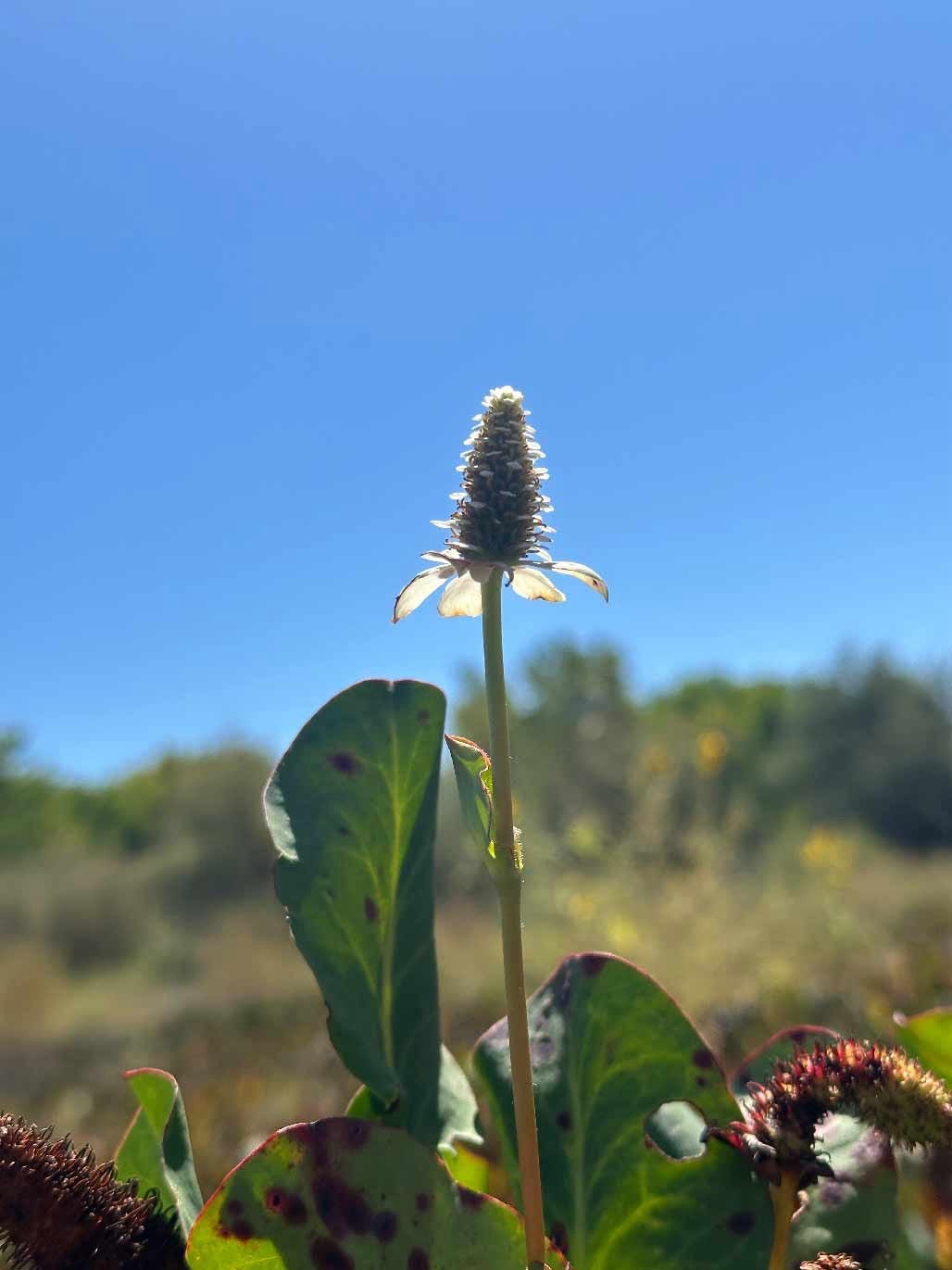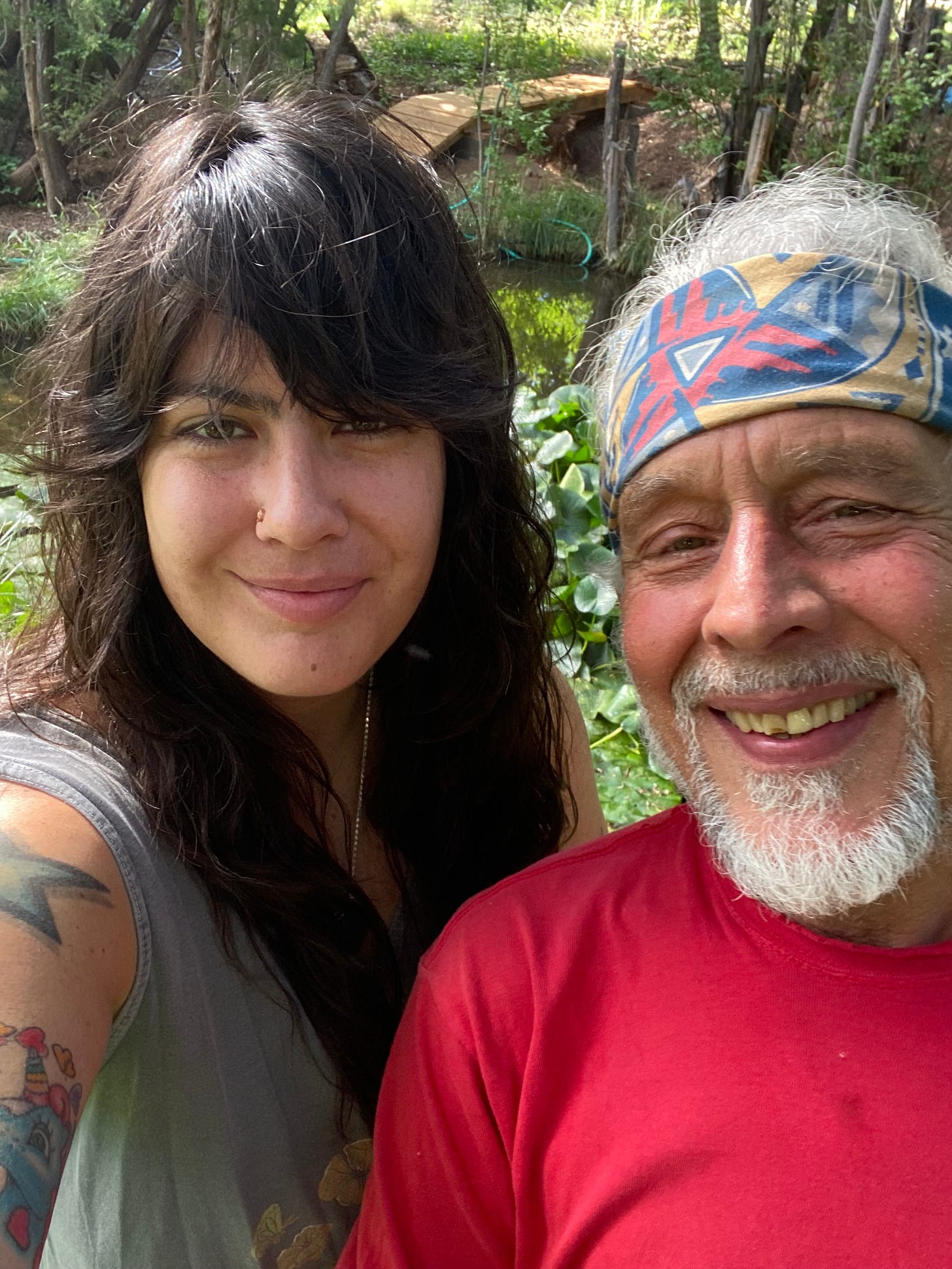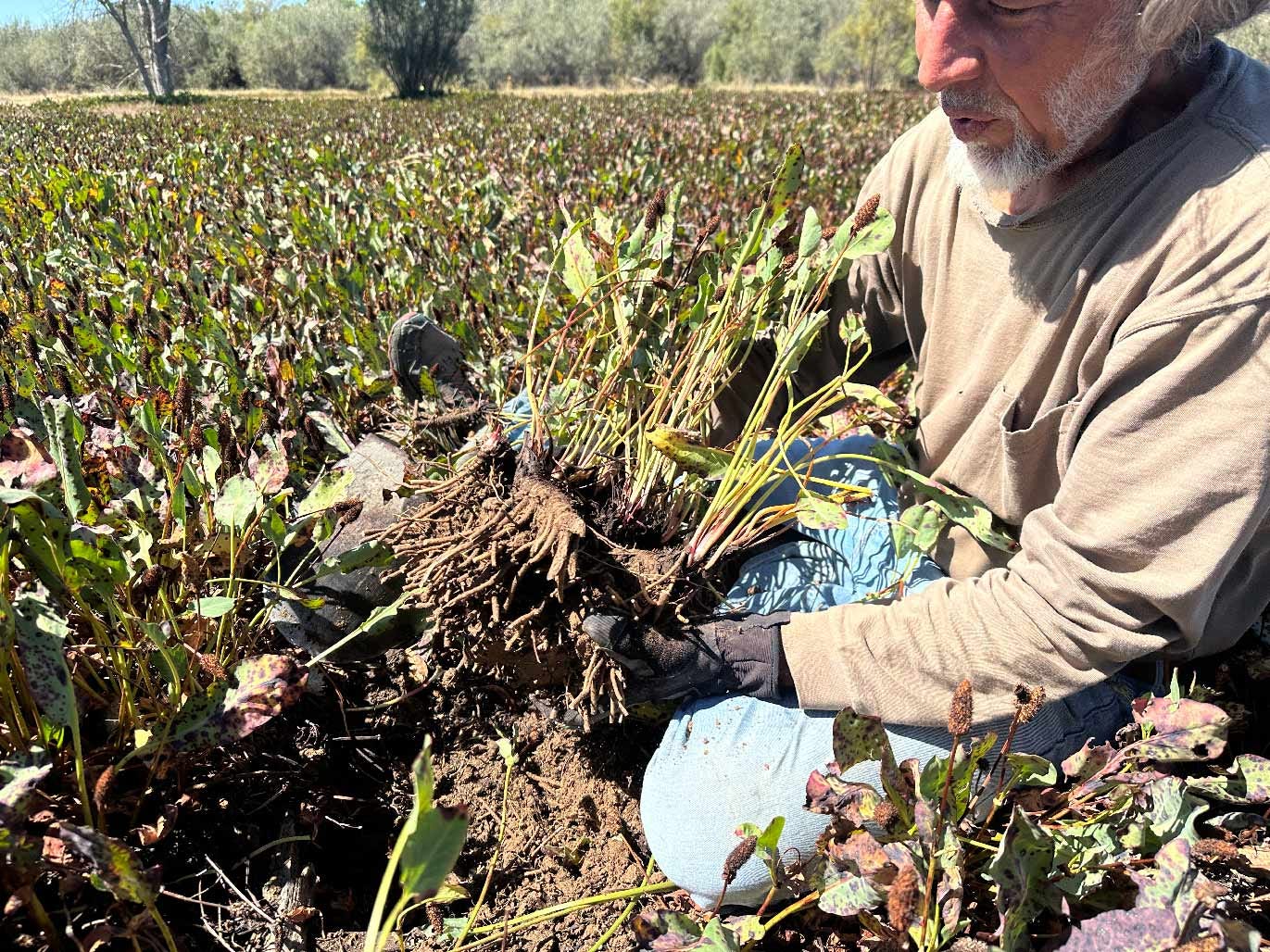By guest writer Lauren Ann Nichols-Sheffler, Senior Sourcing & Purchasing Manager
This post is part of an ethnographic research project with wild harvesters around the world led by the Sustainable Herbs Initiative Wild Plants Working Group. We will continue sharing stories from these interviews.
Discovering Silver City—A Hidden Oasis in New Mexico
Upon arriving in Silver City, I immediately noticed its uniqueness compared to the rest of New Mexico. This small city was greener, boasting a diverse selection of trees and situated at an elevation of 6,200 feet. I flew from Denver, Colorado to discuss one last harvest with expert wildcrafter and clinical herbalist, Richard McDonald. As the Sourcing & Senior Purchasing for a nationally known herbal tincture company, I found myself following the harvest of Yerba Mansa Roots, but didn’t yet know the incredible journey I was about to embark on.
Finding the Mansa Man
The path to Richard’s home was not marked on any map. As GPS faltered, I relied on intuition and the telltale signs of his world—a humble car parked before a tall, weathered chain-link fence adorned with faded prayer flags fluttering like whispers of an older time. Richard greeted me with warm hugs and a light that radiated from a life spent nurturing the earth.
As an herbalist and advocate for sustainable wildcrafting, I was eager to connect with a true elder—a keeper of knowledge in the Southwest where such wisdom has grown scarce. Sharing my initiative’s goals, I emphasized Yerba Mansa’s significance as a legacy herb in Wishgarden Herb’s most trusted formulations, the company I work for. Richard smiled knowingly, understanding the weight of this plant and its story.
An Herbalist’s Sanctuary—Inside Richard’s World
Stepping inside Richard’s adobe-style home, I was met with cool, quiet air—a haven on a 100-degree day. The handcrafted beauty of his space reflected a reverence for tradition. Terra-cotta tile floors lay clean and grounding beneath my feet; thick walls supported by rugged log beams held a sense of permanence.
The monsoons slowly roared like sounds from a hungry belly outside as I sat in his adobe-like kitchen. He happily made me a plant-based smoothie from fruits and herbs grown outside the window and he began telling me about his herbal beginnings.
“Did you build this house yourself?” I asked.
Pride lit up his eyes. “Yes, the whole thing.”
The heart of his home was the kitchen—a living apothecary. Hand-pressed tincture equipment, mason jars brimming with bio-regional herbs, and even a 5-gallon glass carboy of vibrant plum wine told stories of artistry and resourcefulness. Richard began recounting his roots as an herbalist.
From Apprentice to Steward—Richard’s Herbal Beginnings
Richard’s journey began at the Southwest School of Botanical Medicine under the legendary Michael Moore, founder of The Southwest School of Botanical Medicine. His education shaped him into a clinical herbalist, wildcrafter, and ethical steward. For decades, he solely ran Silver City’s food co-op, complete with an apothecary and clinic. Sourcing and harvesting his plants responsibly, he created teas, tinctures, and topicals under his company, Desert Bloom Herbs—a name synonymous with sustainability. A photo of Michael Moore smiled down from the wall, a constant reminder of Richard’s deep-rooted lineage. Over 32 years, Richard became a guardian of the Southwest wildlands, specializing in harvesting Yerba Mansa along the Rio Grande Bosques.
As our visit continued, I asked numerous questions about his house and life, to which he responded with sincere emotion and honesty. He often reminisced about his wife, Phillis, who passed away 16 years ago —a profoundly difficult time as he cared for her. He dearly missed his herbal partner and best friend. Despite his loss, Richard remains dedicated to our planet and our plant friend’s future.
When I asked him what he enjoyed most about harvesting, he replied, “Conversations with the plants and being where they are. It’s not a spoken conversation, it's a conversation you have in your head. It brings my attention to certain things. It reminds me to chew on it for my gums.
It’s a positive connection, we want to know you. We want you to take us and discover what we do. Maybe at some point, you don’t think and it’s an idea of how to use the plant in a different way. I feel like that’s how we get to know what to do with plants and testing. It’s important to be with the plants.”
A Land of Mansa and Metamorphosis
As morning softened into afternoon, Richard led me outside to explore his one-acre sanctuary. A great pond, adorned with lily pads and buzzing dragonflies, mirrored the beauty of life he has cultivated. The scent of cedar and juniper intertwined with the earth’s sweetness, but the treasure lay beside the water—tall Yerba Mansa plants, growing in lush clusters.
I knelt beside the plants, marveling at their bright green, rubbery leaves and red stolons snaking horizontally outward, rooting for new life. “They spread like lizards’ tails,” Richard explained, referencing the name given to Yerba Mansa by Southwest First Nation tribes. With careful hands, he demonstrated how these stolons re-root, propagating new Mansa plants in 6- 9 months. After the tails re-establish roots in the ground, Richard cuts the cord, much like an umbilical cord as the new baby plants begin their life. This plant, it seemed, could easily be cultivated under the right conditions and with the care of a generous steward.
We sat by the pond, surrounded by Yerba Mansa plants, and discussed all aspects of herbalism. At one point, I noticed a large, slightly orange dragonfly clinging to the underside of a Yerba Mansa leaf, next to an exceptionally ugly dark bug. Richard explained the dragonfly's metamorphic changes, launching us into another deep discussion. As I sat listening, I couldn’t help but think how I ended up here, in this magical moment, honored to be his student. Could it be that Mansa’s calling brought me here? I couldn’t wait for my first official root harvest, though bittersweet as it would be Richard’s last official Mansa harvest.
The Last Harvest—Sacred Moments in the Bosque
As we greet the early days of Autumn, their cool embrace over the New Mexico Bosque, the air, still warmed by the lingering summer sun, fills our wildcrafting excursion with an unexpected honorable adventure. This seasonal metamorphosis not only heralds a time of tangible change but also ushers in a period of renewal and profound enlightenment beneath the expansive canopy of the ancient Cottonwood Bosque.
Venturing one mile into the wild, armed with shovels, water, backpacks, harvest bags, and hearts full of noble intentions, we followed the sandy trail flanked by willow trees and towering wild sunflowers. At the trail’s end, we would find our cherished botanical ally, Yerba Mansa. Its intoxicating, spicy-carrot-like scent envelops me, transporting me to a sacred communion with Mansa—as if greeting an old friend who jests, "What took you so long?"
The foliage of Mansa, tinged with hues of orange and red yet hosting the last of its blooms, contrasts with the vibrant green leaves of the cottonwoods overhead, which offer a cool shelter from the intense solar rays. As Richard initiates our lesson in the delicate art of uprooting yet conscientiously replanting 40% of what we excavate, large red-winged blackbirds glide above. A gentle breeze caresses my face, carrying the rhythmic rustle of cottonwood leaves and enriching the air with Richard’s sage advice.
A Legacy in Every Root
For three decades, Richard has been the guardian of this wild sanctuary. Throughout these years, he has cultivated a practice of harvesting only what is needed and then returning or propagating the roots back to the nurturing soil. He shares, “They thrive in companionship, benefitting from the symbiotic relationships with decomposing wood that neighbors them.” Known affectionately as the Mansa Man (a name I gave him), Richard has gleaned extensive insights into the natural habitats of Mansa, knowledge that proves invaluable for stakeholders aspiring to cultivate or continue working with Yerba Mansa on a broader scale. His stewardship not only preserves but also propagates the legacy of this vital Southwestern herb, ensuring its survival and flourishing population in the heart of the Bosque.
Immersed for a week within the nurturing Bosque, alongside Richard, we found ourselves more attuned to the earth, its flora, and the depths of our own spirits. Under his guidance, we engaged in the ancient practice of harvesting, a communion with nature that allowed us to mindfully gather the necessary bounty for our cherished Wishgarden formulations, Deep Lung and Get Over It. With each careful selection, rooted in good intentions, we secured our annual essentials.
Conclusion: Walking Beside Nature—A Call to Stewardship
When I left Richard and Bosque, I carried more than herbs and tinctures. I carried a lesson—that stewardship is love in action. Richard McDonald’s life is a quiet masterpiece of reciprocity and reverence. The Mansa Man has not only preserved Yerba Mansa but also its spirit, teaching us to walk beside nature—not above it.
In a world that often forgets its roots, Richard stands as a beacon of hope, a reminder that balance and care will guide us home to the wild.
Lauren Ann Nichols-Sheffler attended The Colorado School of Clinical Herbalism and received her certificate in medical herbalism. She is the owner of Blue Yarrow Herbs aka Herbal Vice, an herbal product company practicing bioregional herbalism by cultivating plants and sourcing locally. Lauren loves educating and advocating for plant sustainability. She is the sourcing and Purchasing manager for WishGarden Herbs.
For educational purposes only. This information has not been evaluated by the Food and Drug Administration. This information is not intended to diagnose, treat, cure, or prevent any disease, or sell any product.







